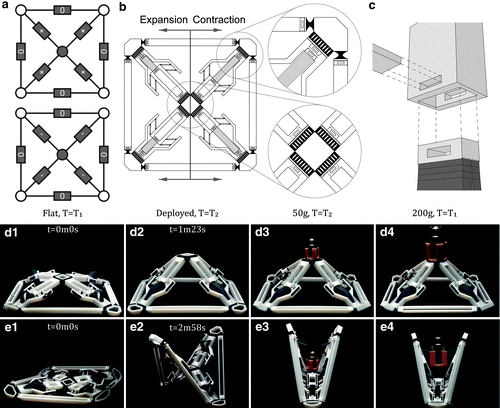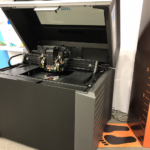

There are numerous issues involved with transporting things into space, one being that some of them are just too big and bulky. One solution is to make those items small and capable of being folded up into compact packages which can then be expanded once the destination is reached. 4D printing is frequently used to create these deployable objects; a shape memory polymer will be 3D printed and “programmed” to unfold or expand when exposed to a stimulus such as light or temperature change. There are challenges with this technology, too, however: the energy sources themselves can be bulky, deployment can be imprecise, components can jam, and the objects can lack structural integrity.
Professor Kristina Shea and doctoral student Tian Chen of the Swiss Federal Institute of Technology Zurich (ETH Zurich), who recently used 3D printing to develop an underwater soft robot, have published a study in which they 3D printed a programmable actuator that deploys autonomously and changes shape using temperature change as the catalyst. The study, entitled “An Autonomous Programmable Actuator and Shape Reconfigurable Structures Using Bistability and Shape Memory Polymers,” can be accessed here.
“Using a shape memory polymer as the temperature controllable energy source and a bistable mechanism as the linear actuator and force amplifier, the structures achieve precise geometric activation and quantifiable load-bearing capacity,” the researchers explain. “The proposed unit actuator integrates these two components and is designed to be assembled into larger deployable and shape reconfigurable structures.”
The 3D printed objects were programmed to change shape gradually by tailoring each shape memory polymer to a different activation time. The objects started as flat surfaces that, when activated, transformed into a pyramid or a hyperbolic paraboloid shape, demonstrating a multistate structure. Both showed load-bearing capability during activation and operation.
Shea and Chen used multimaterial inkjet 3D printing technology to fabricate complex designs by selectively depositing photoreactive liquid resins of different stiffness and glass transition temperatures.

“By combining this polymer with a bistable mechanism, called a von Mises truss, we are able to define two distinct equilibrium states that can be precisely achieved,” the researchers explain. “Von Mises type bistable mechanisms have previously been used in active masts, for energy absorption, and more recently to create 3D-printed reconfigurable structures.”
The items were 3D printed using a Stratasys Objet3 Connex500 multimaterial 3D printer. The materials used were FLX9895, a shape memory polymer; RGD525, a temperature-resistant rigid plastic; and Agilus30, an elastomer-like material. The structures were then activated using heated water to simulate a reduced gravity environment.
“The deployment of the unit actuator procedure consists of two phases; the first phase is the programming and assembly of the SMS with the bistable mechanism,” the researchers continue. “The second is the constrained recovery of the SMS and consequently the activation of the unit actuator. In the programming phase, the SMS is heated past and is either stretched or compressed by a distance equal to the stroke length of the bistable mechanism (Fig. 2b, c). While confined, the SMS is cooled and installed in the bistable mechanism (Fig. 2d). The second phase is triggered by raising the temperature of the unit actuator past (Fig. 2e). As the SMS recovers, it triggers the bistable mechanism and achieves the deployed state. Once cooled, this activated state behaves as a rigid structure as the SMS returns to its glassy state.”
The result is an object that smoothly transforms from a flat state into a complex shape, and most importantly, shows load-bearing capabilities both during and after deployment, unlike many other 4D printed objects. The research has the potential to be used for a number of applications, particularly in the field of space exploration.
Discuss this and other 3D printing topics at 3DPrintBoard.com or share your thoughts below.
If you're looking to get architectural 3D animation in the USA, our service provides an exceptional way to bring your architectural concepts to life through dynamic, immersive visuals. Through our platform, you can easily request high-quality 3D animations that showcase your designs in motion, offering a detailed view of your project from multiple angles and perspectives. Whether it's for a real estate development, a commercial building, or an urban planning project, our expert team ensures that every detail is captured in a visually compelling animation.
Through our website, you can seamlessly get architectural 3D animation tailored to your project’s specific needs. With our help, you can offer potential clients or investors an engaging experience that goes beyond static images. By integrating CGI animations with real-world settings, lighting, and textures, our team creates a lifelike experience that allows your audience to interact with your project as though it were already built. This service is perfect for presenting complex designs in a clear, visually attractive way that stands out in the competitive architectural market.




